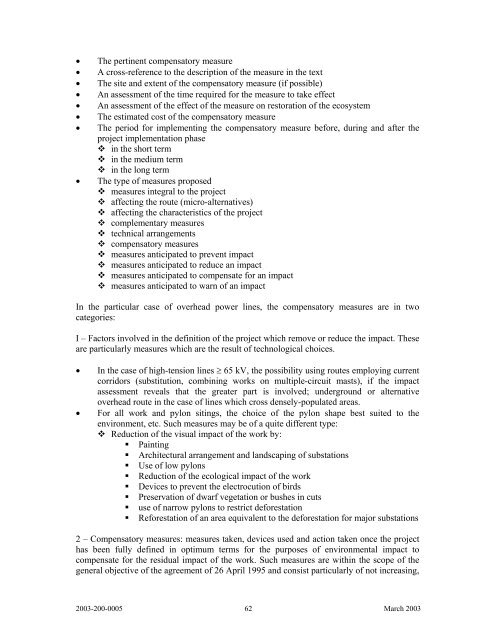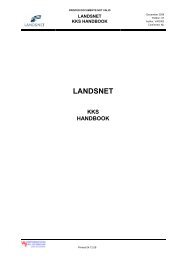Public Acceptance for new transmission overhead lines ... - Landsnet
Public Acceptance for new transmission overhead lines ... - Landsnet
Public Acceptance for new transmission overhead lines ... - Landsnet
Create successful ePaper yourself
Turn your PDF publications into a flip-book with our unique Google optimized e-Paper software.
• The pertinent compensatory measure<br />
• A cross-reference to the description of the measure in the text<br />
• The site and extent of the compensatory measure (if possible)<br />
• An assessment of the time required <strong>for</strong> the measure to take effect<br />
• An assessment of the effect of the measure on restoration of the ecosystem<br />
• The estimated cost of the compensatory measure<br />
• The period <strong>for</strong> implementing the compensatory measure be<strong>for</strong>e, during and after the<br />
project implementation phase<br />
� in the short term<br />
� in the medium term<br />
� in the long term<br />
• The type of measures proposed<br />
� measures integral to the project<br />
� affecting the route (micro-alternatives)<br />
� affecting the characteristics of the project<br />
� complementary measures<br />
� technical arrangements<br />
� compensatory measures<br />
� measures anticipated to prevent impact<br />
� measures anticipated to reduce an impact<br />
� measures anticipated to compensate <strong>for</strong> an impact<br />
� measures anticipated to warn of an impact<br />
In the particular case of <strong>overhead</strong> power <strong>lines</strong>, the compensatory measures are in two<br />
categories:<br />
I – Factors involved in the definition of the project which remove or reduce the impact. These<br />
are particularly measures which are the result of technological choices.<br />
• In the case of high-tension <strong>lines</strong> ≥ 65 kV, the possibility using routes employing current<br />
corridors (substitution, combining works on multiple-circuit masts), if the impact<br />
assessment reveals that the greater part is involved; underground or alternative<br />
<strong>overhead</strong> route in the case of <strong>lines</strong> which cross densely-populated areas.<br />
• For all work and pylon sitings, the choice of the pylon shape best suited to the<br />
environment, etc. Such measures may be of a quite different type:<br />
� Reduction of the visual impact of the work by:<br />
� Painting<br />
� Architectural arrangement and landscaping of substations<br />
� Use of low pylons<br />
� Reduction of the ecological impact of the work<br />
� Devices to prevent the electrocution of birds<br />
� Preservation of dwarf vegetation or bushes in cuts<br />
� use of narrow pylons to restrict de<strong>for</strong>estation<br />
� Re<strong>for</strong>estation of an area equivalent to the de<strong>for</strong>estation <strong>for</strong> major substations<br />
2 – Compensatory measures: measures taken, devices used and action taken once the project<br />
has been fully defined in optimum terms <strong>for</strong> the purposes of environmental impact to<br />
compensate <strong>for</strong> the residual impact of the work. Such measures are within the scope of the<br />
general objective of the agreement of 26 April 1995 and consist particularly of not increasing,<br />
2003-200-0005 62 March 2003






